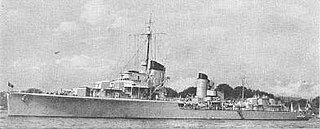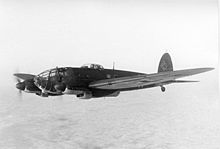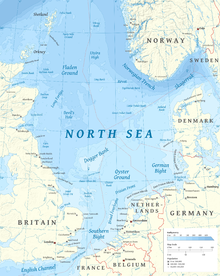
Admiral Hipper was the lead ship of the Admiral Hipper class of heavy cruisers which served with Nazi Germany's Kriegsmarine during World War II. The ship was laid down at the Blohm & Voss shipyard in Hamburg in July 1935 and launched February 1937; Admiral Hipper entered service shortly before the outbreak of war, in April 1939. The ship was named after Admiral Franz von Hipper, commander of the German battlecruiser squadron during the Battle of Jutland in 1916 and later commander-in-chief of the German High Seas Fleet. She was armed with a main battery of eight 20.3 cm (8 in) guns and, although nominally under the 10,000-long-ton (10,160 t) limit set by the Anglo-German Naval Agreement, actually displaced over 16,000 long tons (16,260 t).

The German destroyer Z1 Leberecht Maass was the lead ship of her class of four destroyers built for the German Navy during the mid-1930s. Completed in 1937, two years before the start of World War II, the ship served as a flagship and spent most of her time training, although she did participate in the occupation of Memel in early 1939.

Martin Harlinghausen was a German military aviator and general. Harlinghausen specialised in maritime interdiction and anti-warship operations. During World War II Harlinghausen was the leading exponent of anti-ship warfare with the destruction of 22 ships credited to him.

Kampfgeschwader 26 "Löwengeschwader" was a German air force Luftwaffe bomber wing unit during World War II. Its units participated on all of the fronts in the European Theatre until the end of the war. It operated three of the major German aircraft medium bomber types; the Heinkel He 111, Junkers Ju 88 and the Junkers Ju 188. The unit engaged in both strategic bombing, close air support, anti-shipping and aerial interdiction operations. The majority of its operational life – not entirely unlike another Luftwaffe wing designated KG 40 — was spent on anti-shipping missions.

The German destroyer Z2 Georg Thiele was one of four Type 1934-class destroyers built for the German Navy (Kriegsmarine) during the mid-1930s. She was named after Georg Thiele, a Korvettenkapitän who commanded the Seventh Half Flotilla of torpedo boats. Completed in 1937, two years before the start of World War II, the ship spent most of her time training although she did participate in the occupation of Memel in early 1939.
Z3 Max Schultz was one of four Type 1934 destroyers built for the German Navy (Kriegsmarine) during the mid-1930s. Completed in 1937, two years before the start of World War II, the ship spent most of her time training although she did participate in the occupation of Memel in early 1939. Shortly before the beginning of World War II, the ship accidentally rammed and sank a German torpedo boat. Z3 Max Schultz spent the following month under repair. In mid-February 1940, while proceeding into the North Sea to search for British fishing trawlers, one of her sisters, Z1 Leberecht Maass, was bombed and sunk by a patrolling German bomber, with loss of 280 of her crew. While trying to rescue survivors, Z3 Max Schultz was either bombed by a patrolling German bomber, or struck a British mine and sunk, with the loss of all 308 of her crew. A contemporary German court of inquiry stated that Z3 Max Schultz was damaged by the German bomber, however postwar research revealed that Z3 Max Schultz may have hit a mine instead.

The German destroyer Z4 Richard Beitzen was one of four Type 1934 destroyers built for the German Navy (Kriegsmarine) during the mid-1930s. Completed in 1937, the ship spent most of her time training although she did participate in the occupation of Memel in early 1939. At the beginning of World War II in September 1939, the ship was initially deployed to blockade the Polish coast, but was soon transferred to the Kattegat where she inspected neutral shipping for contraband goods. In late 1939 and early 1940, the ship laid two offensive minefields off the English coast that claimed 17 merchant ships. Z4 Richard Beitzen was in reserve during the Norwegian Campaign of early 1940 and was transferred to France later that year, where she made several attacks on British shipping.

The German destroyer Z6 Theodor Riedel was a Type 1934A-class destroyer built for the Kriegsmarine during the mid-1930s. At the beginning of World War II in September 1939, the ship laid defensive minefields to the North Sea. She covered her sister ships over the next few months as they laid offensive minefields in English waters in late 1939–early 1940. She participated in the early stages of the Norwegian Campaign by transporting troops to the Trondheim area in early April 1940 and was transferred to France later that year where the ship covered another minelaying sortie before engine problems caused her to return to Germany in November for repairs. Theodor Riedel was badly damaged when she ran aground three days after her repairs were completed and was out of action until May 1942.
Z8 Bruno Heinemann was a Type 1934A-class destroyer built for Nazi Germany's Kriegsmarine in the mid-1930s. After the start of World War II in September 1939, she blockaded the Polish coast and searched neutral shipping for contraband. In late 1939 and early 1940 the ship made three successful minelaying sorties off the English coast that claimed 17 merchant ships. Bruno Heinemann participated in the early stages of the Norwegian Campaign by transporting troops to the Trondheim area in early April 1940. The ship was transferred to France a year later to escort German ships that used the French ports on the Atlantic coast. She was returning to France in early 1942 when she struck two mines and sank off the coast of Belgium.

Z9 Wolfgang Zenker was a Type 1934A-class destroyer built for Nazi Germany's Kriegsmarine in the mid-1930s. Several days after the start of World War II, she unsuccessfully attacked, together with another destroyer, Polish ships anchored at the naval base on the Hel Peninsula. In early 1940 the ship made two successful minelaying sorties off the English coast that claimed six merchant ships. Wolfgang Zenker participated in the early stages of the Norwegian Campaign by transporting troops to the Narvik area in early April 1940. The ship fought in both naval Battles of Narvik several days later and had to be scuttled after she exhausted her ammunition.

Z10 Hans Lody was a Type 1934A-class destroyer built for Nazi Germany's Kriegsmarine in the mid-1930s. At the beginning of World War II on 1 September 1939, the ship was initially deployed to blockade the Polish coast, but she was quickly transferred to the North Sea to lay defensive minefields. In late 1939 the ship laid multiple offensive minefields off the English coast that claimed nine merchant ships and she crippled a British destroyer during one of these missions.
Z13 Erich Koellner was a Type 1934A-class destroyer built for Nazi Germany's Kriegsmarine in the late 1930s. At the beginning of World War II, the ship was still working up. In early 1940 she made two successful minelaying sorties off the English coast that claimed six merchant ships. During the early stages of the Norwegian Campaign, Erich Koellner fought in both naval Battles of Narvik in mid-April 1940 and was severely damaged by British ships during the Second Battle of Narvik. The ship was scuttled by her crew shortly afterwards.
Z14 Friedrich Ihn was a Type 1934A-class destroyer built for Nazi Germany's Kriegsmarine in the mid-1930s. The ship was named after the First World War German naval officer Friedrich Ihn. At the beginning of World War II, the ship was initially deployed to blockade the Polish coast, but she was quickly transferred to the German Bight to lay defensive minefields in German waters. In late 1939 and early 1940, the ship laid multiple offensive minefields off the English coast that claimed 18 merchant ships and a destroyer. Ihn was under repair during the Norwegian Campaign of early 1940 and was transferred to France later that year.
Z15 Erich Steinbrinck was a Type 1934A-class destroyer built for Nazi Germany's Kriegsmarine in the mid-1930s. The ship was named after the First World War German naval officer Erich Steinbrinck. At the beginning of World War II on 1 September 1939, the ship was initially deployed to blockade the Polish coast, but she was quickly transferred to the North Sea to lay defensive minefields. In late 1939 and 1940 the ship laid multiple offensive minefields off the English coast that claimed 24 merchant ships and a destroyer. Steinbrinck was under repair for most of the Norwegian Campaign of early 1940 and was transferred to France later that year.

Z16 Friedrich Eckoldt was a Type 1934A-class destroyer built for Nazi Germany's Kriegsmarine in the late 1930s. It was named after Kapitänleutnant Friedrich Eckoldt (1887–1916), the commander of torpedo boat V 48, who was killed when his boat was sunk during the Battle of Jutland on 31 May 1916.

Z19 Hermann Künne was one of six Type 1936 destroyers built for the Kriegsmarine in the late 1930s. Completed at the beginning of 1939, the ship spent most of her time training although she did participate in the occupation of Memel a few months later. At the beginning of World War II in September, she was initially deployed to lay minefields off the German coast, but was soon transferred to the Skagerrak where she inspected neutral shipping for contraband goods. In late 1939, Z18 Hans Lüdemann helped to laid four offensive minefields off the English coast that claimed two British destroyers and thirty-eight merchant ships.

Z20 Karl Galster was one of six Type 1936 destroyers built for the Kriegsmarine in the late 1930s. Completed in early 1939, the ship spent most of her time training. At the beginning of World War II in September, she was initially deployed to lay minefields off the German coast, but was soon transferred to the Skagerrak where she inspected neutral shipping for contraband goods. In late 1939 and early 1940, Z20 Karl Galster helped to laid three offensive minefields off the English coast that claimed one British destroyer, a fishing trawler, and twenty merchant ships. After a refit that prevented her from participating in the German invasion of Norway in April, the ship was sent to Norway for escort duties. Later that year Z20 Karl Galster was transferred to France, where she made several attacks on British shipping.

Z29 was one of fifteen Type 1936A destroyers built for the Kriegsmarine during World War II. Completed in 1941, she took part in the Channel Dash in early 1942 as flagship of the escort force. Despite this venture to France, the ship spent most of the war in Norwegian waters, escorting German ships and laying minefields. Z29 participated in the indecisive Battle of the Barents Sea at the end of the year, during which she helped to sink a British minesweeper. The ship was damaged during the raid on the island of Spitsbergen in September 1943. Z29 was damaged by British aircraft attacking the battleship Tirpitz in July 1944. The ship escorted troop convoys from northern Norway when the Germans began evacuating the area beginning in October until she began an extensive refit in December.

Z30 was one of fifteen Type 1936A destroyers built for the Kriegsmarine during World War II. Completed in 1941, the ship was transferred to Norwegian waters in early 1942 where she remained for most of the rest of her career, escorting convoys and laying minefields. She played a minor role in the indecisive Battle of the Barents Sea at the end of the year and was damaged during the raid on the island of Spitsbergen in September 1943.

The Type 1934 destroyers, also known as the Z1 class or Leberecht Maass class after the lead ship, were a group of four destroyers built for the German Navy during the mid-1930s, shortly before the beginning of World War II. The ships were engaged in training for most of the period between their commissioning and the outbreak of war, although they did participate in the occupation of Memel in Lithuania, in early 1939. Z3 Max Schultz collided with and sank a German torpedo boat shortly before the war began on 1 September 1939. All four ships were named after German officers who had been killed in World War I.













